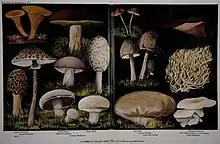
An edible item is any item that is safe for humans to eat. "Edible" is differentiated from "eatable" because it does not indicate how an item tastes, only whether it is fit to be eaten. Nonpoisonous items found in nature – such as some mushrooms, insects, seaweed, and so forth – are referred to as edible. Processed items that normally are not ingested but are specially manufactured to be so, like edible underwear or edible packaging, are also labeled as edible.[1]
Edible items in nature
Humans eat thousands of plant species; there may be as many as 75,000 edible species of angiosperms, of which perhaps 7,000 are often eaten.[2]
Edible plants found in nature include flowers, seeds, berries, seaweed, and cacti. Being able to identify the versions of these plants that are safe to eat is an important survival skill.[3] Some fungi, including certain types of mushrooms, are also edible.
Many animals are also edible, including domesticated livestock as well as wild insects, amphibians, reptiles, birds and mammals.[4] Advocates of the increase in consumption of edible insects cite the environmental benefits of being able to raise more food using less land while producing fewer greenhouse emissions. More than 1,900 insect species have been documented as being used for food, including ants and beetle larvae in the diets of some African and Australian tribes, and crispy-fried locusts and beetles enjoyed as street food in parts of Thailand.[5]
Etymology
The term "edible" dates back to the 1590s. It originates from the Latin word "edibilis" (eatable), which comes from the word "edere" (to eat), which comes from the prefix "ed-" (to eat).[6]
References
- ↑ "Usage Notes: Putting 'Edible' and 'Eatable' on the Table". Merriam-Webster. 30 December 2019. Archived from the original on 18 December 2020. Retrieved 22 December 2020.
- ↑ Şerban, Procheş; Wilson, John R. U.; Vamosi, Jana C.; Richardson, David M. (1 February 2008). "Plant Diversity in the Human Diet: Weak Phylogenetic Signal Indicates Breadth". BioScience. 58 (2): 151–159. doi:10.1641/B580209.
- ↑ Department of the Army (23 June 2009). The Complete Guide to Edible Wild Plants. Skyhorse Publishing. ISBN 9781626369825. Archived from the original on 27 March 2023. Retrieved 19 March 2023.
- ↑ Adi, Annis Catur; Andrias, Dini Ririn; et al. (2020). "The potential of using wild edible animals as alternative food sources among food-insecure areas in Indonesia". Journal of Health Research. 34 (3): 247–257. doi:10.1108/JHR-07-2019-0156. S2CID 212411553.
- ↑ Van Huis, Arnold; Van Itterbeeck, Joost; et al. (2013). "Edible insects: future prospects for food and feed security". Food and Agriculture Organization of the United Nations. 171. Archived from the original on 31 December 2020. Retrieved 22 December 2020.
- ↑ "edible". Online Etymology Dictionary. Archived from the original on 2021-06-13. Retrieved 2020-12-27.